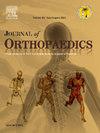Analysis of adolescent idiopathic scoliosis population for Surgical Site Infection Risk Factors
IF 1.5
Q3 ORTHOPEDICS
引用次数: 0
Abstract
Objective
The incidence of surgical site infection (SSI) in adolescent idiopathic scoliosis (AIS) patients undergoing surgical correction varies but is commonly reported between 0.5 and 6.7 %. The identification of modifiable risk factors is crucial to preventing these infections in the AIS population. Some potential modifiable risk factors include the use of stainless-steel implants, a larger volume of instrumentation and an increased volume of blood products transfused. However, evidence in support of these factors and others representing true risk for the development of SSI is limited and often varies. We aimed to determine the incidence of SSI in AIS undergoing primary scoliosis fusion at our hospital, and explore demographic and clinical variables in the development of SSI in AIS.
Methods
This was a case control retrospective study. Patients aged 10-19 year-old that underwent posterior spinal fusion for initial correction of AIS at our hospital between the years 2012–2020 were eligible. Patients with any previous spine surgery or spine fracture were excluded. A descriptive analysis was then performed on the data.
Results
Of the 334 patients on which data was collected, one SSI was identified resulting in an incidence of infection of 0.3 %. The largest ethnicity represented was Caucasian with 254 patients. The average age was 14.3 years with averaged follow-up of 6.6 years. The majority of patients (252) received implants composed of titanium and cobalt chrome. The average operation duration was 5 h and 7.7 min, and the average hospital stay was 4.2 days. The average amount of blood loss was 553 ml. Chlorhexidine wipes or some other antimicrobial preparation was used on 197 patients and betadine solution was used on 321.185 patients were recorded to have received either antibiotic-loaded allograft or antibiotic powder and 326 patients were recorded to have received intraoperative antibiotics.
Conclusions
The long term clinical follow up of our study and low incidence of infection provide additional evidence for the benefit of antimicrobial techniques and risk factor mitigation previously suggested in the literature for the prevention of SSI in AIS.
Level of evidence
Level III.
青少年特发性脊柱侧凸人群手术部位感染风险因素分析
目的接受手术矫正的青少年特发性脊柱侧弯症(AIS)患者的手术部位感染(SSI)发生率各不相同,但据报道通常在 0.5% 到 6.7% 之间。确定可改变的风险因素对于预防青少年特发性脊柱侧凸患者感染至关重要。一些潜在的可改变风险因素包括使用不锈钢植入物、较大的器械使用量和增加的血液制品输注量。然而,支持这些因素和其他因素代表 SSI 真正发病风险的证据有限,而且往往各不相同。我们的目的是确定在我院接受原发性脊柱侧凸融合术的 AIS 中 SSI 的发生率,并探讨 AIS 中发生 SSI 的人口统计学和临床变量。研究对象为2012-2020年间在我院接受脊柱后路融合术初次矫正AIS的10-19岁患者。曾接受过脊柱手术或脊柱骨折的患者除外。结果 在收集到数据的 334 例患者中,发现了 1 例 SSI,感染率为 0.3%。白种人最多,有 254 名患者。患者平均年龄为 14.3 岁,平均随访时间为 6.6 年。大多数患者(252 人)接受了由钛和钴铬组成的植入物。手术时间平均为 5 小时 7.7 分钟,平均住院时间为 4.2 天。平均失血量为 553 毫升。有记录显示,185 名患者接受了含抗生素的异体移植或抗生素粉末,326 名患者接受了术中抗生素治疗。结论我们的研究进行了长期临床随访,感染发生率较低,这进一步证明了抗菌技术和减轻风险因素对预防 AIS 感染 SSI 的益处。
本文章由计算机程序翻译,如有差异,请以英文原文为准。
求助全文
约1分钟内获得全文
求助全文
来源期刊

Journal of orthopaedics
ORTHOPEDICS-
CiteScore
3.50
自引率
6.70%
发文量
202
审稿时长
56 days
期刊介绍:
Journal of Orthopaedics aims to be a leading journal in orthopaedics and contribute towards the improvement of quality of orthopedic health care. The journal publishes original research work and review articles related to different aspects of orthopaedics including Arthroplasty, Arthroscopy, Sports Medicine, Trauma, Spine and Spinal deformities, Pediatric orthopaedics, limb reconstruction procedures, hand surgery, and orthopaedic oncology. It also publishes articles on continuing education, health-related information, case reports and letters to the editor. It is requested to note that the journal has an international readership and all submissions should be aimed at specifying something about the setting in which the work was conducted. Authors must also provide any specific reasons for the research and also provide an elaborate description of the results.
 求助内容:
求助内容: 应助结果提醒方式:
应助结果提醒方式:


